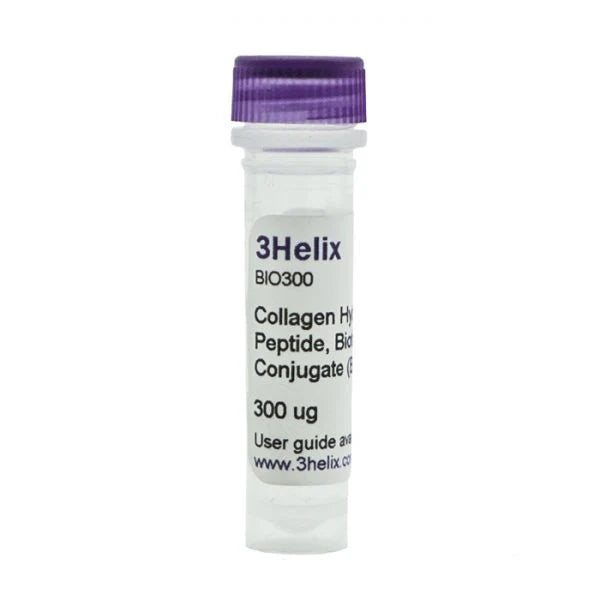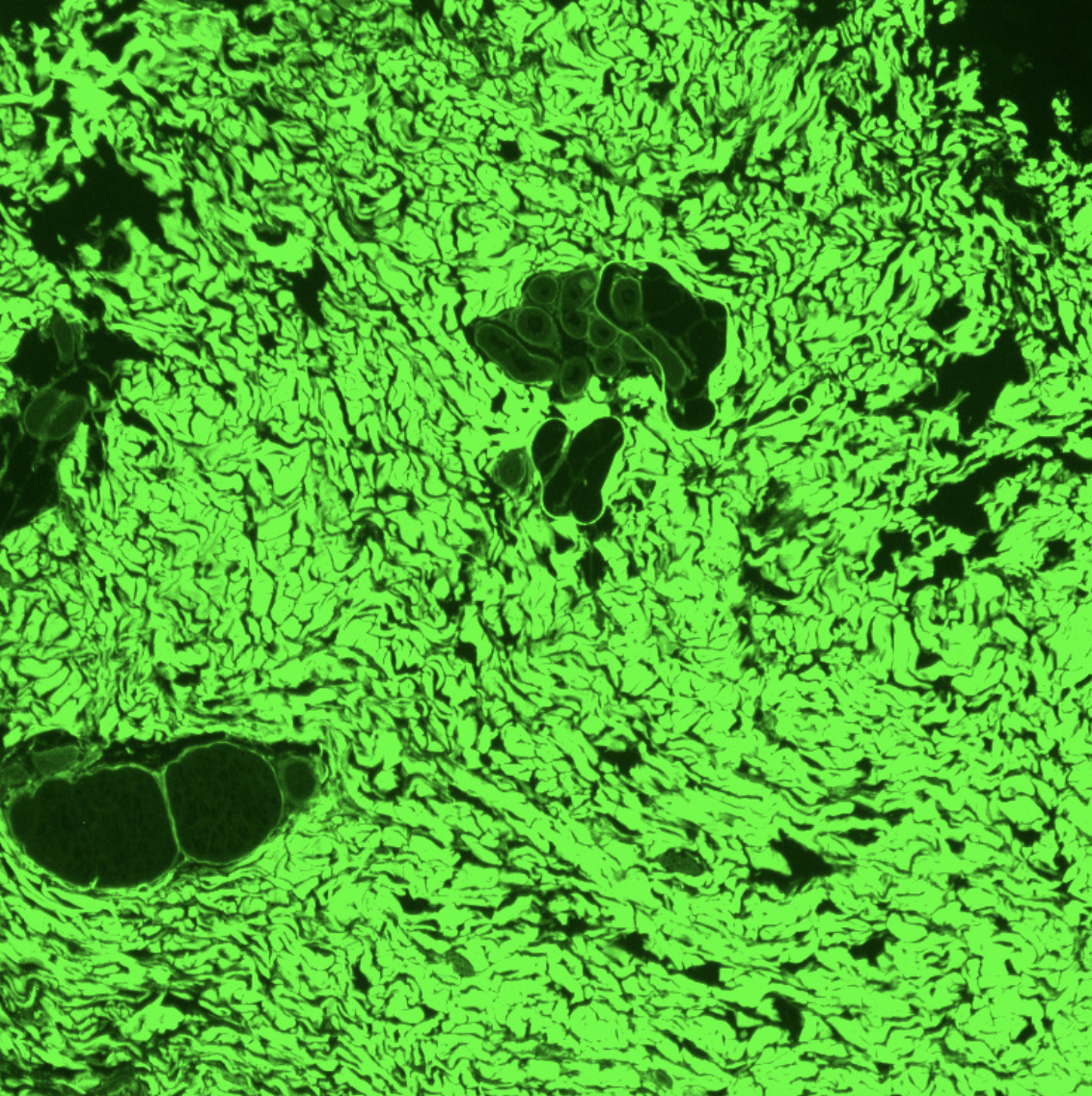Popular right now
Lots of people have looked at this recently
Selling fast!
Grab yours while you can
B-CHP | Collagen Hybridizing Peptide, Biotin Conjugate
- 300μg
- Scrambled Control (60μg)
Care information
Care information
Display general product information or specific product information using metafields.
Delivery and Shipping
Delivery and Shipping
Add some general information about your delivery and shipping policies.

B-CHP | Collagen Hybridizing Peptide, Biotin Conjugate
Payment & Security
Payment methods
Your payment information is processed securely. We do not store credit card details nor have access to your credit card information.
Product Description
Description
The collagen hybridizing peptide (CHP) is a novel and unique peptide that specifically binds unfolded collagen chains, both in vitro and in vivo.[1,2,3] By sharing the Gly-X-Y repeating sequence of natural collagen, CHP has a strong capability to hybridize with denatured collagen chains by reforming the triple helical structure, in a fashion similar to DNA fragments annealing to complementary DNA strands. CHP is extremely specific: it has negligible affinity to intact collagen molecules due to lack of binding sites, and it is inert towards non-specific binding because of its neutral and hydrophilic nature.
CHP is a powerful histopathology tool which enables straightforward detection of inflammation and tissue damage caused by a large variety of diseases, as well as tissue remodeling during development and aging.[3] CHP robustly visualizes the pericellular matrix turnover caused by proteolytic migration of cancer cells within 3D collagen culture, without the use of synthetic fluorogenic matrices or genetically modified cells.[4] CHP can measure and localize mechanical injury to collagenous tissue at the molecular level.[5] It also enables assessment of collagen denaturation in decellularized extracellular matrix.[6] In addition, CHP can be used to specifically visualize collagen bands in SDS-PAGE gels without the need for western blot.[7]
B-CHP is labeled with biotin for avidin/streptavidin-mediated detection. B-CHP offers flexible detection options, such as non-green fluorescence and HRP-enzyme methods, to avoid background and enhance signal.
Specificity: CHP binds to the unfolded triple-helical chains of all collagen types (e.g., I, II, III, IV, etc).[3,7]
Applications: immunofluorescence,[3] immunohistochemistry[3]
Specification
| Synonyms | B-CHP, collagen mimetic peptide (CMP) |
| Molecular weight | 2762.01 g/mol |
| Purity | 95% by HPLC |
| Conjugate | Single biotin tag per peptide |
| Content | Purified lyophilized powder |
| Storage | -20 °C as powder, 4 °C after reconstitution in water |
Features
- More informative, reliable and convenient than zymography, DQ collagen, SHG, and TEM
- High affinity and unparalleled specificity to collagen with essentially no nonspecific binding
- Applicable to all types of collagen from all species, relying on collagen's secondary structure instead of any defined sequence for binding
- Suitable for both frozen and paraffin-embedded sections with no need for antigen retrieval
- A non-antibody approach with no species restrictions against any co-staining antibody
- Small size (2% of IgG by MW) enabling facile tissue penetration and whole specimen staining without sectioning
- Stable in solution under 4 °C, eliminating the need to aliquot for storage
Special applications
B-CHP provides the flexibility for visualizing damaged collagen using any user-selected fluorophore (e.g., AlexaFluor dyes conjugated streptavidin), or a non-fluorescence method (e.g., through NeutrAvidin-HRP mediated DAB staining).
In addition, B-CHP and commercial streptavidin-conjugated gold nanoparticles can be used in combination to label unfolded collagen molecules under TEM: collagen fibers in an intact or mechanically overloaded rat tail tendon probed by B-CHP and streptavidin conjugated 10nm-sized gold nanoparticles (scale bar: 200 nm).

For research use only. Not intended or approved for diagnostic or therapeutic use.
Citation
- ACS Nano. 2017 Oct 24;11(10):9825-9835. doi: 10.1021/acsnano.7b03150. Epub 2017 Sep 18.
- J Histochem Cytochem. 2024 Feb;72(2):79-94. doi: 10.1369/00221554231225995. Epub 2024 Jan 24.
- Biomedicines. 2024 Jan 19;12(1):230. doi: 10.3390/biomedicines12010230.
- Caves, Elizabeth Ann. Mechanisms and Functions of Lipodystrophy in Dermal Fibrosis. Diss. Yale University, 2024.
- Nakagawa, K., Nakashima, Y. Pathogenesis of human atheroma necrotic core: degradation of connective tissue fibers and possible involvement of cathepsin K. transl med commun 9, 26 (2024). https://doi.org/10.1186/s41231-024-00188-6
- Lee, Soo Jung et al. “A midposition NOTCH3 truncation in inherited cerebral small vessel disease may affect the protein interactome.” The Journal of biological chemistry vol. 299,1 (2023): 102772. doi:10.1016/j.jbc.2022.102772
- Feng, Xiaotian et al. “Apical expansion of calvarial osteoblasts and suture patency is dependent on graded fibronectin cues.” bioRxiv : the preprint server for biology 2023.01.16.524278. 16 Jan. 2023, doi:10.1101/2023.01.16.524278. Preprint.
- J Biomech. 2023 Apr;151:111546. doi: 10.1016/j.jbiomech.2023.111546. Epub 2023 Mar 15.
- Brown, Anthony et al. “Natural Retinol Analogs Potentiate the Effects of Retinal on Aged and Photodamaged Skin: Results from In Vitro to Clinical Studies.” Dermatology and therapy vol. 13,10 (2023): 2299-2317. doi:10.1007/s13555-023-01004-z
- Polymers (Basel). 2023 Sep 7;15(18):3683. doi: 10.3390/polym15183683.
- Gallate, Zachary S et al. “Galectin-3 and RAGE differentially control advanced glycation endproduct-induced collagen damage in murine intervertebral disc organ culture.” JOR spine vol. 6,2 e1254. 28 Mar. 2023, doi:10.1002/jsp2.1254
- Petrocelli, Jonathan J et al. “Disuse-induced muscle fibrosis, cellular senescence, and senescence-associated secretory phenotype in older adults are alleviated during re-ambulation with metformin pre-treatment.” Aging cell vol. 22,11 (2023): e13936. doi:10.1111/acel.13936
- Hettinger, Zachary R et al. “Mechanotherapy Reprograms Aged Muscle Stromal Cells to Remodel the Extracellular Matrix during Recovery from Disuse.” Function (Oxford, England) vol. 3,3 zqac015. 24 Mar. 2022, doi:10.1093/function/zqac015
- Int J Mol Sci. 2022 Apr 12;23(8):4245. doi: 10.3390/ijms23084245.
- Biomed Opt Express. 2022 Mar 22;13(4):2346-2363. doi: 10.1364/BOE.448286. eCollection 2022 Apr 1.
- Am J Physiol Heart Circ Physiol. 2022 Jul 1;323(1):H165-H175. doi: 10.1152/ajpheart.00148.2022. Epub 2022 Jun 3.
- Gallate, Zachary S. Galectin-3 Mediates Advanced Glycation Endproduct-Induced Collagen Damage in Intervertebral Discs. MS thesis. Icahn School of Medicine at Mount Sinai, 2022.
- Jenkins, Edmund Charles et al. “Age alters the oncogenic trajectory toward luminal mammary tumors that activate unfolded proteins responses.” Aging cell vol. 21,10 (2022): e13665. doi:10.1111/acel.13665
- Aging Cancer. 2022 Jun;3(2):116-129. doi: 10.1002/aac2.12049. Epub 2022 Apr 19.
- Goss, Georgina. Distinct Fibroblast and Pericyte Lineages in Skin Development and Repair. Diss. King's College London, 2022.
- Yu, Dan. Mechanisms and effects of femtosecond laser micromachining in ophthalmic materials and ocular tissue. University of Rochester, 2021.
- Arvind, Varun, Kristen Howell, and Alice H. Huang. "Reprogramming adult tendon healing using regenerative neonatal regulatory T cells." bioRxiv (2021): 2021-05.
- Wang, William Y et al. “Dynamic Endothelial Stalk Cell-Matrix Interactions Regulate Angiogenic Sprout Diameter.” Frontiers in bioengineering and biotechnology vol. 9 620128. 19 Mar. 2021, doi:10.3389/fbioe.2021.620128
- Filiberti, Adrian et al. “An intact complement system dampens cornea inflammation during acute primary HSV-1 infection.” Scientific reports vol. 11,1 10247. 13 May. 2021, doi:10.1038/s41598-021-89818-9
- Zhang, Xiaojie et al. “Hydrolysis of a second Asp-Pro site at the N-terminus of NOTCH3 in inherited vascular dementia.” Scientific reports vol. 11,1 17246. 26 Aug. 2021, doi:10.1038/s41598-021-96679-9
- Viiklepp, Kristina et al. “C1r Upregulates Production of Matrix Metalloproteinase-13 and Promotes Invasion of Cutaneous Squamous Cell Carcinoma.” The Journal of investigative dermatology vol. 142,5 (2022): 1478-1488.e9. doi:10.1016/j.jid.2021.10.008
- Jussila, Anna R et al. “Skin Fibrosis and Recovery Is Dependent on Wnt Activation via DPP4.” The Journal of investigative dermatology vol. 142,6 (2022): 1597-1606.e9. doi:10.1016/j.jid.2021.10.025
- Rognoni, Emanuel et al. “Role of distinct fibroblast lineages and immune cells in dermal repair following UV radiation-induced tissue damage.” eLife vol. 10 e71052. 23 Dec. 2021, doi:10.7554/eLife.71052
- Saini, K., et al. "Heterogeneous strains in tissue collagen show that high strains locally suppress degradation by collagenase." bioRxiv (2021): 2021-02.
- Vagnozzi, Ronald J et al. “An acute immune response underlies the benefit of cardiac stem cell therapy.” Nature vol. 577,7790 (2020): 405-409. doi:10.1038/s41586-019-1802-2
- Filiberti, Adrian et al. “Loss of Osteopontin Expression Reduces HSV-1-Induced Corneal Opacity.” Investigative ophthalmology & visual science vol. 61,10 (2020): 24. doi:10.1167/iovs.61.10.24
- J Orthop Surg Res. 2019 Jun 10;14(1):172. doi: 10.1186/s13018-019-1217-7.
- Rognoni, Emanuel et al. “Fibroblast state switching orchestrates dermal maturation and wound healing.” Molecular systems biology vol. 14,8 e8174. 29 Aug. 2018, doi:10.15252/msb.20178174
- Jin, Hyo-Eon et al. “Collagen mimetic peptide engineered M13 bacteriophage for collagen targeting and imaging in cancer.” Biomaterials vol. 35,33 (2014): 9236-45. doi:10.1016/j.biomaterials.2014.07.044
- J Cell Sci. 2020 Dec 11;133(23):jcs248278. doi: 10.1242/jcs.248278.
- Horn, Lucas A et al. “Remodeling the tumor microenvironment via blockade of LAIR-1 and TGF-β signaling enables PD-L1-mediated tumor eradication.” The Journal of clinical investigation vol. 132,8 (2022): e155148. doi:10.1172/JCI155148
- JOR Spine. 2020 Sep 21;3(4):e1126. doi: 10.1002/jsp2.1126. eCollection 2020 Dec.







